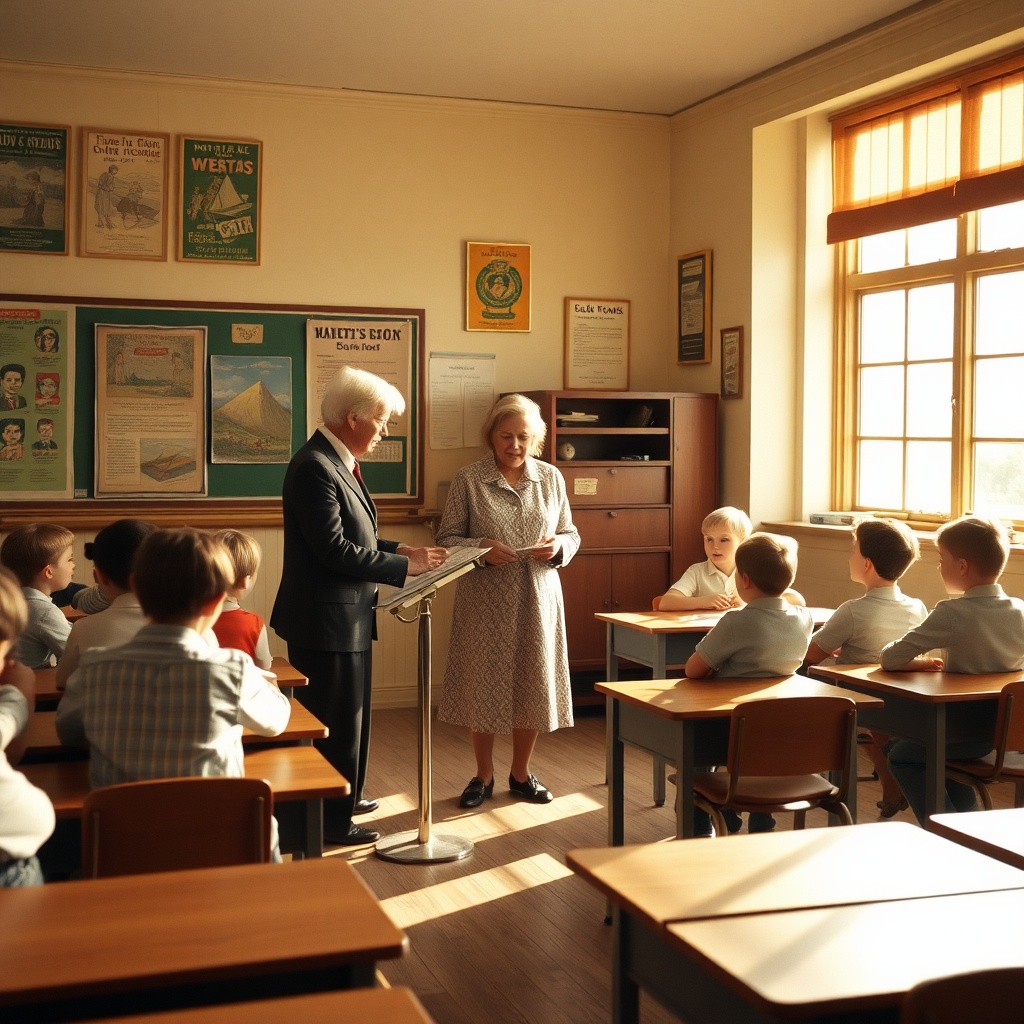Reflections on Authority: How Corporal Punishment Shaped Discipline

Understanding the Context
In the 1960s, schools across many parts of the world operated under a strict regime of discipline, where corporal punishment was often seen as a necessary tool for maintaining order. Can you remember the atmosphere of your classrooms during that time? The clack of rulers and the echo of paddles were not just sounds; they were symbols of authority.
The Philosophy Behind Corporal Punishment
Corporal punishment was justified by many educators and parents as a means of instilling respect and obedience in students. It was believed that physical discipline would deter misbehavior and promote a sense of responsibility. How did this philosophy resonate with your experiences in school?
- Historical Perspective: Corporal punishment was common in many educational systems worldwide.
- Role of Authority Figures: Teachers and school administrators were seen as the ultimate authority, often wielding their power without question.
Methods of Discipline
Reflect on the methods used during your school days. Do you remember any specific incidents that stand out? Here are some common practices:
- Physical Punishment: This included spanking, paddling, or striking students for various infractions.
- Public Humiliation: Students were often reprimanded in front of their peers, which served to reinforce authority through fear.
Consequences of Corporal Punishment
While some argue that corporal punishment produced disciplined students, others highlight its negative consequences. How did discipline affect your peers and your own development?
- Psychological Impact: Many students experienced anxiety and fear as a result of potential physical punishment.
- Resentment Towards Authority: Some students grew to distrust or resent authority figures due to harsh disciplinary measures.
Shifts in Perspective
As societal views evolved, so did the perception of corporal punishment. What changes did you notice in the approach to discipline as the years passed?
- Rise of Alternative Methods: By the late 1970s and 1980s, many schools began to adopt non-violent disciplinary strategies.
- Legal Changes: Numerous regions began to outlaw corporal punishment, reflecting a shift in societal attitudes towards children’s rights.
Conclusion: A Reflection on Authority
As we reflect on the impact of corporal punishment in the 1960s, it’s crucial to consider its lasting effects on today’s educational landscape. What are your thoughts on the balance between authority and empathy in schools? How do you believe discipline should be handled now compared to the past?
Voices from the Past: Personal Stories of Discipline in 1960s Classrooms

Introduction to Discipline in 1960s Classrooms
As we journey back to the 1960s, we invite you to reflect on the experiences of those who endured the rigorous discipline of the era. For many, school was not just a place of learning but a battlefield of rules and consequences. Through personal stories, we uncover the emotional tapestry woven by memories of discipline and the lasting impact it has had on lives.
Personal Stories: A Tapestry of Experiences
| Name | Story Summary |
|---|---|
| John Smith | John recalls the day he was sent to the principal’s office for talking back. He vividly remembers the fear and shame that washed over him, as well as the unexpected compassion he received from the principal, who shared his own struggles. |
| Mary Johnson | Mary shares her experience of being paddled for not completing her homework. The pain was physical, but the emotional scars lingered much longer, shaping her views on authority. |
| Robert Williams | Robert’s story involves witnessing a classmate get punished severely. This incident instilled a sense of injustice in him, leading to a lifelong advocacy against corporal punishment. |
Reflection on Discipline’s Legacy
The echoes of discipline in the 1960s are not just stories of punishment, but narratives of resilience, fear, and the quest for understanding. As we reflect on these personal accounts, consider how they resonate with your own experiences in education.
Interactive Engagement: Share Your Story
We invite you to share your own stories of discipline from the 1960s. What were your experiences? How did they shape you? Your voice adds to the rich history of education during this transformative decade.
The Ripple Effect: Lasting Consequences of Corporal Punishment on Generations

The 1960s was a decade marked by significant social change, yet one aspect remained deeply entrenched in the educational system: corporal punishment. Its presence in schools was not just a method of discipline but a practice that has left lasting marks on generations. Let us explore the ripple effects of corporal punishment and how they reverberate through time.
The Nature of Corporal Punishment
Corporal punishment typically involved physical discipline, such as spanking or paddling. Many educators believed that such methods instilled discipline and respect among students. However, this technique often fostered an environment of fear rather than learning. How did this affect students in the long term?
Psychological Implications
Research has increasingly shown that corporal punishment can lead to several psychological issues. Children who experienced physical punishment often exhibited:
| Psychological Issue | Description |
|---|---|
| Low Self-Esteem | Feeling of worthlessness due to harsh discipline. |
| Increased Aggression | Learning to resolve conflicts through violence. |
| Anxiety Disorders | Living in fear of punishment can lead to chronic anxiety. |
Generational Effects
The impact of corporal punishment is not confined to those who experienced it directly. Parents who were punished as children often replicate those methods, believing they are instilling discipline. This cycle perpetuates a culture of violence in homes and schools:
Cycle of Violence: Many adults who were subjected to corporal punishment may struggle with anger management and may resort to similar punitive measures with their own children.
Disrupted Relationships: The fear of authority can lead to strained relationships between parents and children, as well as teachers and students.
Long-Term Educational Consequences
Students who faced corporal punishment often had reduced engagement in their education. They might have:
Developed a fear of school, leading to absenteeism.
Struggled with academic performance due to anxiety and low self-worth.
Breaking the Cycle
Recognizing the damaging effects of corporal punishment is crucial for breaking the cycle. How can we make a change? Here are some strategies:
Positive Reinforcement: Encouraging good behavior through rewards rather than punishment.
Open Communication: Fostering an environment where students feel safe to express their feelings and concerns.
Educator Training: Training teachers in alternative disciplinary methods can help create a more supportive learning environment.
The echoes of corporal punishment in the 1960s continue to affect our society today. Understanding its lasting consequences is essential for fostering healthier relationships between educators, parents, and students. By actively working to break this cycle, we can create a more compassionate and effective educational system for future generations.
Navigating Fear and Respect: The Dual Edge of Discipline in Education
In the 1960s, schools were not just places of learning; they were often battlegrounds of authority and control. The methods of discipline employed during this era, particularly corporal punishment, shaped the educational experience in profound ways. This exploration invites you to reflect on the complex nature of discipline—how it was perceived, the emotions it evoked, and its lasting impact on students and educators alike.
The Nature of Discipline in the 1960s
Discipline in schools during this decade was characterized by a strict adherence to rules and an expectation of obedience. The methods used were often severe and included:
- Corporal Punishment: Physical forms of discipline, such as spanking or paddling, were commonplace.
- Public Shaming: Students could face humiliation in front of their peers for misbehaving.
- Detention: Time spent after school as a form of punishment was widely used.
The Psychology of Fear and Respect
There was a delicate balance between fear and respect in the classroom. Educators believed that discipline was essential for maintaining order. However, this often resulted in:
- Fear: Students might comply out of fear of punishment rather than a genuine understanding of right and wrong.
- Respect: Some students respected their teachers for their authority, creating an environment of learning.
Personal Reflections
As you reflect on your own experiences or those of your peers, consider the following:
- How did the discipline you faced shape your view of authority?
- Do you believe fear can coexist with respect in an educational setting?
The Dual Edge of Discipline
| Aspect | Fear | Respect |
|---|---|---|
| Impact on Learning | May hinder creativity and critical thinking. | Can foster a positive learning environment. |
| Long-term Effects | Can lead to distrust in authority figures. | Builds strong role models for future generations. |
| Student-Teacher Relationships | Often strained and based on obedience. | Can lead to mentorship and guidance. |
The echoes of discipline from the 1960s continue to resonate today. As we navigate the complexities of education, it’s vital to understand how the dual forces of fear and respect shaped not only the classroom experience but also the individuals who emerged from it. Reflect on your journey and the lessons learned from this era of discipline.
Lessons Learned: The Evolution of School Discipline Beyond the 1960s
Understanding the Historical Context
Reflecting on the 1960s, a time when corporal punishment was a common practice in schools, we can see how discipline was viewed very differently than today. Can you recall your own experiences or those of your peers during this time? Many schools relied on physical forms of punishment, such as paddling or spanking, believing it instilled respect and obedience.
The Shift in Educational Philosophy
As society progressed, so did the understanding of child psychology and behavior management. Do you remember when discussions about the effects of corporal punishment began to emerge? By the 1970s and 1980s, educators and parents began advocating for more humane and constructive approaches to discipline.
Alternatives to Corporal Punishment
New methods of discipline began to take root, emphasizing positive reinforcement and conflict resolution. Have you seen or experienced these changes in schools? Strategies such as:
Restorative Justice – Focusing on repairing harm rather than punishment.
Positive Behavioral Interventions and Supports (PBIS) – Encouraging good behavior through rewards.
Social-Emotional Learning (SEL) – Teaching children to manage emotions and build healthy relationships.
Effects of Corporal Punishment on Students
Research has shown that corporal punishment can lead to long-term emotional and psychological effects, including increased aggression and anxiety. What do you think about these findings? The conversation around these issues has led to a broader understanding of how discipline affects a child’s development.
A Look at Modern Disciplinary Practices
Today, many schools have adopted zero-tolerance policies for violence and are moving towards inclusive disciplinary practices. How do you feel about the current methods used in schools today? This evolution reflects a commitment to fostering a safe and supportive learning environment for all students.
Engaging in the Conversation
As we consider the lessons learned from the past, it is essential to engage in conversations about the future of school discipline. What insights can you share from your own experiences that might inform current practices? Your perspectives are invaluable in shaping a more compassionate approach to education.
Conclusion: Building a Better Future
In closing, the evolution of school discipline from the 1960s to today highlights a significant shift in our understanding of students’ needs. How can we continue to advocate for positive changes in education? By learning from the past and embracing new strategies, we can ensure that all children are treated with the respect and dignity they deserve.
